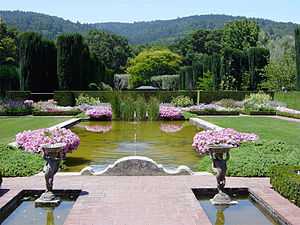Groundskeeping
- Groundskeeper redirects here.

Groundskeeping is the activity of tending an area of land for aesthetic or functional purposes; typically in an institutional setting. It includes mowing grass, trimming hedges, pulling weeds, planting flowers, etc. The U.S. Department of Labor estimated that more than 900,000 workers are employed in the landscape and groundskeeping services industry in the United States in 2006. Of these over 300,000 workers were groundskeepers for golf courses, schools, resorts, and public parks.[1] Compare gardener.
A groundskeeper is a person who maintains landscaping, gardens or sporting venues (and their vegetation where appropriate) for appearance and functionality. In Britain the word groundsman (occasionally groundswoman if appropriate) or park keeper is used much more commonly. In Australia, the word curator is often used for a person undertaking this job, especially those involving cricket pitches. At university campuses, groundskeepers are often called horticulturists. The equivalent on a golf course is a greenskeeper.
Groundskeepers
A groundskeeper's job requires a wide range of knowledge of horticulture, pest control, and weed abatement. As many institutions (especially schools) are moving away from the use of chemical pesticides and toward integrated pest management the experience, knowledge and scholastic requirements of top groundskeepers are increasing. While groundskeepers usually follow a site plan created by a landscape architect, there can be many opportunities for creativity in detailed design and presentation.
Groundskeeping equipment
Groundskeeping equipment comprise implements and vehicles used in groundskeeping, including:
- mowers
- lawn mowers
- tractors
- string trimmers
- snow blowers
- snow plows
- edgers
- rotary brushes
- rakes
- Leaf blower
- shovels
- trowels
- sprinklers
- garden tools
- Watering can or truck mounted watering system (polyethylene tank and hoses)
Environmental impact
Pollution from gas-powered groundskeeping equipment is a significant source of air pollution.[2] US emission standards specifically limit emissions from small engines. Electric models produce no emissions at the point of use, but may shift pollution to power plants. Emissions may still be reduced by the use of renewable energy in grid generation, or because central power plants generally must have stricter emissions control equipment installed.
In fiction
Groundskeepers have appeared occasionally as minor characters in fiction and moving images. They are usually presented as comic or peculiar characters, often exhibiting a compulsive or obsessive personality defect.
Some examples of fictional groundskeepers include:
- On Cartoon Network's animated series Regular Show Mordecai, Rigby, Skips, Muscle Man and High Five Ghost are Groundskeepers at a local city park
- Groundskeeper Willie is a gruff speaking Scot in the television animated series The Simpsons. He is both a groundskeeper and a janitor.
- Ben Weatherstaff in the The Secret Garden, is the only adult in the story to have some idea of the children's doings.
- Carl Spackler is an assistant groundskeeper played by actor Bill Murray in the movie Caddyshack, who obsessively pursues the destruction of a gopher on the golf course that he maintains.
- Boothby is the longtime Starfleet Academy groundskeeper and grandfatherly figure to many cadets in the Star Trek series The Next Generation, Deep Space Nine, and Voyager.
- Chauncey Gardiner, played by Peter Sellers in Being There. In this case the character is central to the plot. Although of limited intelligence (from our viewpoint) he uniquely mirrors all who interact with him and so becomes a popular persona, even to the point of being suggested by others as a possible United States presidential candidate.
- Rubeus Hagrid is the half-Giant groundskeeper at Hogwarts in the Harry Potter book series.
See also
- Organic horticulture
- List of organic gardening and farming topics
- American gardeners
- Professional Grounds Management Society
References
- Notes
- ↑ The National Institute for Occupational Safety and Health. "Fact Sheet: Fatal Injuries Among Landscape Services Workers". DHHS Publication 2008-144. October 2008. Accessed 10-22-2008.
- ↑ Lawn Equipment | Improving Air Quality in Your Community | US EPA